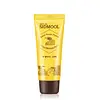What's inside
What's inside
 Key Ingredients
Key Ingredients

 Benefits
Benefits

 Ingredients Side-by-side
Ingredients Side-by-side

Honey Extract 40%
HumectantWater
Skin ConditioningAloe Barbadensis Leaf Juice
Skin ConditioningGlycerin
HumectantGlycereth-26
HumectantHyaluronic Acid
HumectantSorbitol
HumectantPropolis Extract
Skin ConditioningRoyal Jelly Extract
Skin ConditioningSh-Oligopeptide-1
Skin ConditioningSh-Polypeptide-11
Oligopeptide-2
Skin ConditioningHydrolyzed Collagen
EmollientBeta-Glucan
Skin ConditioningPortulaca Oleracea Extract
Skin ConditioningOriganum Vulgare Leaf Extract
Skin ConditioningCaffeoyl Tripeptide-1
AntioxidantChamomilla Recutita Flower Extract
MaskingGlycine Max Seed Extract
Skin ConditioningScutellaria Baicalensis Root Extract
AstringentButylene Glycol
HumectantSucrose
HumectantFructose
HumectantGlucose
HumectantTrehalose
HumectantPanthenol
Skin ConditioningDipotassium Glycyrrhizate
HumectantAllantoin
Skin ConditioningGlucosylrutin
AntioxidantArginine
MaskingCarbomer
Emulsion StabilisingXanthan Gum
Emulsifying1,2-Hexanediol
Skin ConditioningHoney Extract 40%, Water, Aloe Barbadensis Leaf Juice, Glycerin, Glycereth-26, Hyaluronic Acid, Sorbitol, Propolis Extract, Royal Jelly Extract, Sh-Oligopeptide-1, Sh-Polypeptide-11, Oligopeptide-2, Hydrolyzed Collagen, Beta-Glucan, Portulaca Oleracea Extract, Origanum Vulgare Leaf Extract, Caffeoyl Tripeptide-1, Chamomilla Recutita Flower Extract, Glycine Max Seed Extract, Scutellaria Baicalensis Root Extract, Butylene Glycol, Sucrose, Fructose, Glucose, Trehalose, Panthenol, Dipotassium Glycyrrhizate, Allantoin, Glucosylrutin, Arginine, Carbomer, Xanthan Gum, 1,2-Hexanediol
Rice Ferment Filtrate
Skin ConditioningButylene Glycol
HumectantCaprylic/Capric Triglyceride
MaskingSqualane
Emollient1,2-Hexanediol
Skin ConditioningCetyl Alcohol
EmollientStearyl Alcohol
EmollientLactobacillus Ferment Lysate
Skin ConditioningIsopentyldiol
HumectantWater
Skin ConditioningCeramide NP
Skin ConditioningPropanediol
SolventGlycerin
HumectantBifida Ferment Lysate
Skin ConditioningStreptococcus Thermophilus Ferment
HumectantMadecassoside
AntioxidantAmmonium Acryloyldimethyltaurate/Vp Copolymer
Hydroxyethyl Acrylate/Sodium Acryloyldimethyl Taurate Copolymer
Emulsion StabilisingEthylhexylglycerin
Skin ConditioningRice Ferment Filtrate, Butylene Glycol, Caprylic/Capric Triglyceride, Squalane, 1,2-Hexanediol, Cetyl Alcohol, Stearyl Alcohol, Lactobacillus Ferment Lysate, Isopentyldiol, Water, Ceramide NP, Propanediol, Glycerin, Bifida Ferment Lysate, Streptococcus Thermophilus Ferment, Madecassoside, Ammonium Acryloyldimethyltaurate/Vp Copolymer, Hydroxyethyl Acrylate/Sodium Acryloyldimethyl Taurate Copolymer, Ethylhexylglycerin
 Reviews
Reviews

Ingredients Explained
These ingredients are found in both products.
Ingredients higher up in an ingredient list are typically present in a larger amount.
1,2-Hexanediol is a synthetic liquid and another multi-functional powerhouse.
It is a:
- Humectant, drawing moisture into the skin
- Emollient, helping to soften skin
- Solvent, dispersing and stabilizing formulas
- Preservative booster, enhancing the antimicrobial activity of other preservatives
Butylene Glycol (or BG) is used within cosmetic products for a few different reasons:
Overall, Butylene Glycol is a safe and well-rounded ingredient that works well with other ingredients.
Though this ingredient works well with most skin types, some people with sensitive skin may experience a reaction such as allergic rashes, closed comedones, or itchiness.
Learn more about Butylene GlycolGlycerin is already naturally found in your skin. It helps moisturize and protect your skin.
A study from 2016 found glycerin to be more effective as a humectant than AHAs and hyaluronic acid.
As a humectant, it helps the skin stay hydrated by pulling moisture to your skin. The low molecular weight of glycerin allows it to pull moisture into the deeper layers of your skin.
Hydrated skin improves your skin barrier; Your skin barrier helps protect against irritants and bacteria.
Glycerin has also been found to have antimicrobial and antiviral properties. Due to these properties, glycerin is often used in wound and burn treatments.
In cosmetics, glycerin is usually derived from plants such as soybean or palm. However, it can also be sourced from animals, such as tallow or animal fat.
This ingredient is organic, colorless, odorless, and non-toxic.
Glycerin is the name for this ingredient in American English. British English uses Glycerol/Glycerine.
Learn more about GlycerinWater. It's the most common cosmetic ingredient of all. You'll usually see it at the top of ingredient lists, meaning that it makes up the largest part of the product.
So why is it so popular? Water most often acts as a solvent - this means that it helps dissolve other ingredients into the formulation.
You'll also recognize water as that liquid we all need to stay alive. If you see this, drink a glass of water. Stay hydrated!
Learn more about Water